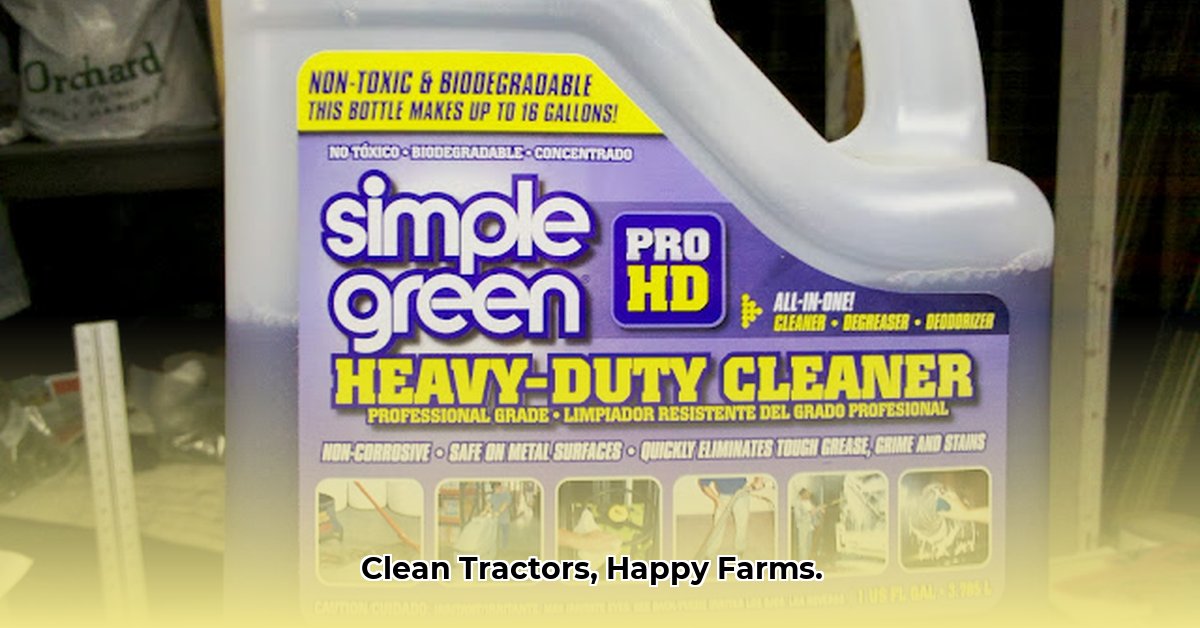
Parts Cleaner Tractor Supply: Keeping Your Tractor Clean and Green
Maintaining your tractor is crucial for a bountiful harvest. A key aspect of this is regular parts cleaning. Tractor Supply offers various parts cleaners, allowing you to choose the best option for your farm's needs and sustainability goals. Let's explore how to select and use these cleaners effectively. Remember to protect your hands with the right safety gloves.
Choosing the Right Tractor Parts Cleaner at Tractor Supply
Tractor Supply provides a range of parts cleaners in different sizes and formulations. Consider your farm's size and cleaning frequency. A larger operation might benefit from a larger, 5-gallon system, while a smaller farm might only need a 1-gallon cleaner for occasional use. But size isn't everything.
The cleaning solution itself is equally important. Some are powerful, tackling heavy grease and grime, but may be harsher on the environment and your tractor's finish. Others are gentler, using biodegradable ingredients which are kinder to the planet and your equipment. Always check the product label for details on its environmental impact and safety instructions—a powerful, eco-friendly cleaner is the ideal balance.
Using Your Parts Cleaner Safely and Effectively: A Step-by-Step Guide
Once you've selected your cleaner, correct usage is vital. Always adhere to the manufacturer's instructions, prioritizing safety. This typically involves wearing gloves and eye protection.
Here's a step-by-step cleaning process:
- Preparation: Begin by removing large debris like mud or dirt with a brush or scraper. This improves cleaner efficiency and reduces waste.
- Application: Submerge smaller parts or carefully spray larger parts, ensuring complete coverage. Follow the product's instructions regarding dwell time.
- Dwell Time: Allow the solution to work; the recommended dwell time maximizes cleaning effectiveness.
- Thorough Rinsing: Rinse parts thoroughly with clean water to eliminate any residual cleaner, preventing corrosion or damage. This is critical for preventing long-term issues.
- Drying: Air dry parts completely. This prevents rust and extends equipment lifespan. Use clean rags if necessary, but air drying is preferable.
Smart Choices for Efficient and Sustainable Cleaning
Consider these factors for maximizing efficiency and minimizing environmental impact:
- Capacity: Choose a size that matches your requirements. Avoid waste by selecting a cleaner appropriate for your farm’s size and cleaning frequency.
- Cleaning Solution Type: Prioritize biodegradable and environmentally friendly solutions. These minimize environmental impact and are gentler on your equipment.
- Maintenance: Regular maintenance extends the cleaner's lifespan and saves money in the long run. This is a simple step with significant economic benefits.
The Environmental Footprint of Your Cleaning Routine: A Comparison
The following table highlights the environmental differences between cleaner types:
| Feature | Environmentally Friendly Cleaner | Harsh Chemical Cleaner |
|---|---|---|
| Cleaning Solution | Plant-based, biodegradable, often non-toxic | Often contains harsh chemicals, potentially toxic |
| Disposal | Generally easily recyclable or biodegradable | May require special hazardous waste disposal |
| Long-Term Impact | Minimizes pollution of water and soil | Potential for water and soil contamination |
Choosing eco-friendly options minimizes pollution, protecting your land and the environment. It's a small step that significantly contributes to sustainable farming practices.
How to Choose Eco-Friendly Parts Cleaners for Sustainable Farm Equipment Maintenance
Key Takeaways:
- Eco-friendly parts cleaners reduce your environmental impact.
- Sustainable practices extend equipment life, saving you money.
- The appropriate cleaner selection depends on the specific cleaning task.
- Responsible disposal of cleaning solutions is essential.
- Preventative maintenance significantly reduces long-term costs.
Sustainable farming practices encompass all aspects of your operation, including equipment maintenance. Let’s explore how to choose eco-friendly parts cleaners effectively.
Understanding the Need for Sustainable Cleaners
Traditional cleaners often contain harsh chemicals harmful to the environment and your health. These pollutants contaminate soil and water sources, impacting wildlife and crops. Eco-friendly alternatives offer superior cleaning power without these harmful side effects.
Types of Eco-Friendly Cleaners
Several eco-conscious options are available:
- Biodegradable Cleaners: These break down naturally, minimizing environmental impact. Look for certifications confirming biodegradability.
- Plant-Based Cleaners: Made from renewable resources, offering a less-toxic alternative.
- Water-Based Cleaners: Using water as the primary solvent, minimizing chemical usage.
Choosing the Right Eco-Friendly Cleaner: A Practical Guide
The best cleaner depends on the specific cleaning task. Consider these key factors for your selection:
- Soil Type: Different cleaners excel at removing grease, mud, or oil.
- Part Material: Ensure the cleaner won't damage the part's surface. Always test on an inconspicuous area first.
- Cleaning Method: Some cleaners are better for soaking, others for spraying.
A Step-by-Step Guide to Sustainable Cleaning
- Preparation: Wear appropriate safety gear (gloves, eye protection). Safety is paramount, so ensure you are adequately protected.
- Pre-Cleaning: Remove loose dirt and debris using a brush or compressed air. This initial step greatly enhances the effectiveness of your cleaner.
- Application: Follow the product instructions for application. This may involve soaking, spraying, or scrubbing.
- Rinsing: Rinse parts thoroughly with clean water to remove all traces of the cleaning solution.
- Disposal: Dispose of cleaning solutions and wastewater responsibly, complying with all local regulations.
The Long-Term Benefits of Eco-Friendly Cleaning
Switching to sustainable cleaners offers significant long-term benefits. You reduce your environmental impact, minimizing your farm's carbon footprint. This results in healthier soil, water, and crops, benefiting your farm and the wider ecosystem. Plus, many eco-friendly cleaners are just as or more effective than harsh chemical alternatives, often being more gentle on your equipment and preserving its lifespan.
Choosing the right cleaner is a crucial step towards sustainable farm equipment maintenance. Remember, sustainable practices are environmentally responsible and economically beneficial. By extending your equipment's life, you save money on replacements and repairs, making eco-friendly choices a smart investment for your farm's future.